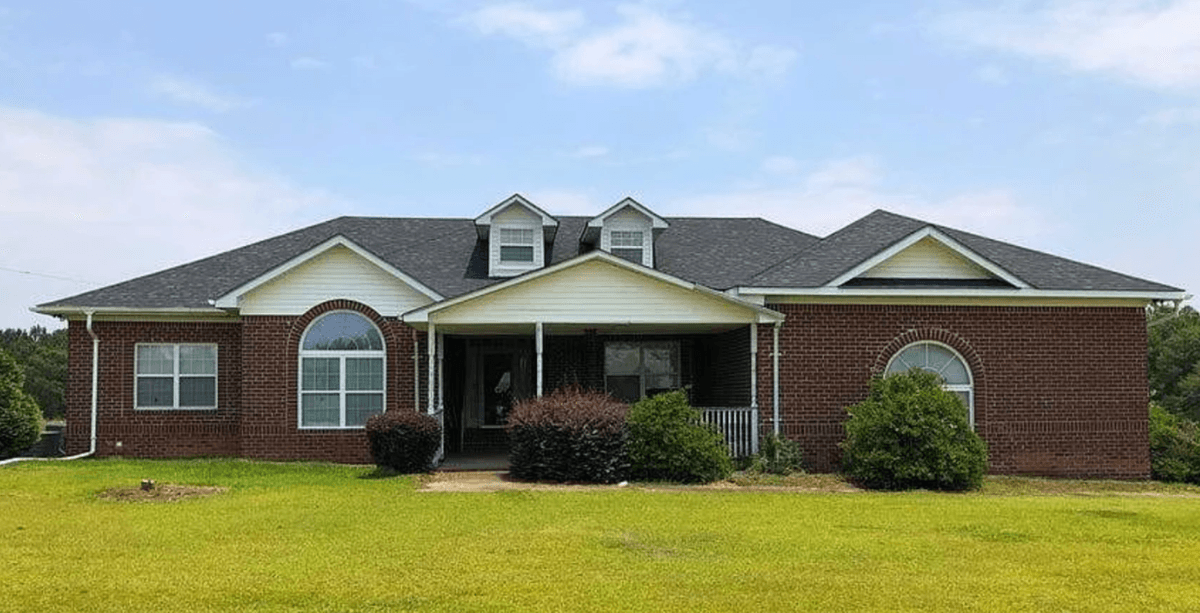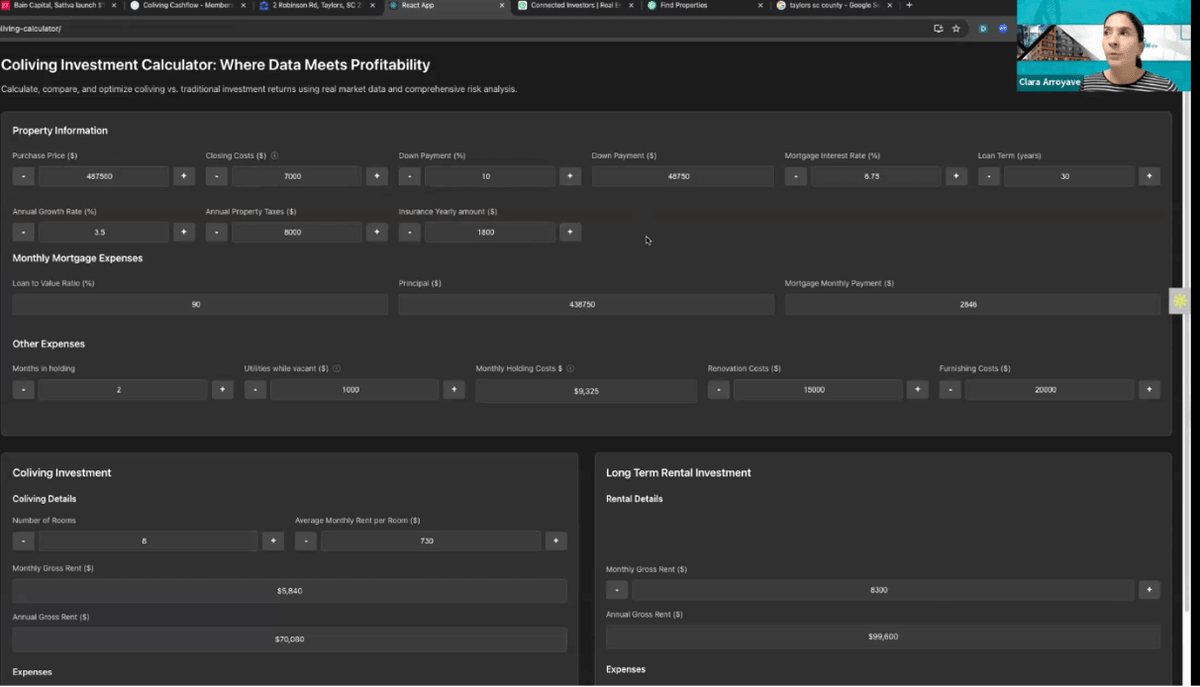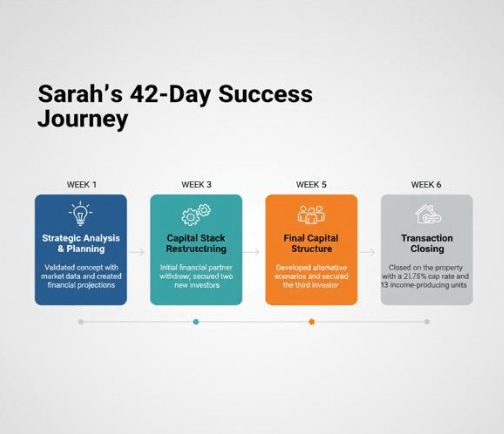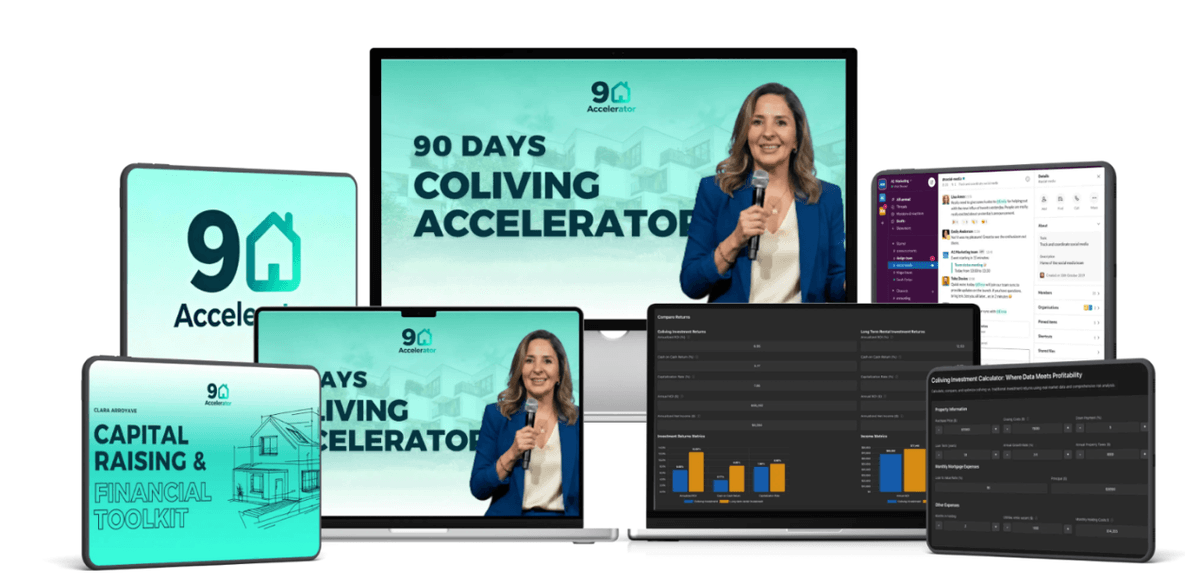Sarah* found a 3,100+ sq ft property in South Carolina. Traditional use projected ~$2,300/mo for a four-bed single-family rental. After three accelerator sessions and a six-week engagement, she closed the property as a 13-unit branded coliving asset projected to generate $105,544 gross revenue and $73,782 net (NOI), ~$6,148/month cash flow, and an implied cap rate of 21.76%. The transaction overcame two investor exits and closed in 42 days, demonstrating how focused underwriting, brand positioning, and creative capital work together to convert an underused asset into a high-yield product.

*name & sensitive details changed for privacy
The challenge — what Sarah faced and why it mattered
Sarah liked the bones of a 3,100+ sq ft house: good location, strong bones, and a layout that suggested multiple private rooms with common areas. But she had four big uncertainties:
- Market fit: Would the local renter population support a multi-room coliving product priced above typical rentals?
- Financial feasibility: Could converting the house to 13 rooms produce competitive returns once renovation, operations and financing costs were included?
- Capital fragility: She had the property under agreement when two financing partners withdrew — a crisis that could have killed the deal.
- Operational readiness: Even if the numbers worked, did she have an operational plan to run a shared-living product (leasing, community, cleaning, tech)?
Left unchecked, each of these issues can sink a project. Our Accelerator approach was designed to address them in parallel: validate demand, model returns, fix capital, and ready operations fast.
Our approach (what we did — enhanced week-by-week breakdown)
Week 1 — Strategic analysis & concept validation (deep dive)
Goal: Convert Sarah’s intuition into investor-grade certainty.
Why this matters: Early assumptions should be turned into testable inputs. Without a data-backed baseline, you risk overbuilding or underpricing.
Deliverables
- Market sizing and demand segmentation
- Pricing grid and sensitivity ranges
- Concept refinement (audience, brand voice, amenity set)
- Unit mix schematic and room-by-room revenue model
- Base pro-forma using the Coliving Calculator™
Actions we took
- Market sizing: Household count: 215,000+
- Renter share: 31% → ~67,000 potential renters
- Competitive audit: studio rents in the catchment area ≈ $1,100+ / month (used as an anchor)
- Why this matters: you need a sufficiently large addressable market to achieve occupancy and to absorb churn.
- Persona & concept
- Chosen persona: early-career professionals and hobbyists who value entertainment and social life.
Concept: “The Ultimate Man Cave” — a lifestyle product with entertainment-first communal spaces (gaming, pool, AV lounge). - Brand positioning: premium private rooms + professionally curated communal rituals (weekly tournaments, “coach night”, movie premieres).
- Why this matters: a clear persona allows focused marketing and amenity selection and justifies premium rents vs a commodity SFR.
- Unit mix & space planning
- Reconfigured the 3,100+ sq ft into 13 units (two of which are standalone studios) while preserving sufficient common area to maintain a high-quality experience.
- Illustrated trade-offs: adding rooms increases revenue but can erode common space value and resident retention if not done thoughtfully.
- Pricing & pro-forma
- Room pricing set: $950–$1,100 depending on room size and privacy.
- Base assumptions: 90% stabilized occupancy, 6% vacancy/turnover adjustment, operating expense ratio derived from comparable coliving projects.
- Key financials (base case):
- Annual gross: $105,544
- NOI: $73,782
- Monthly cash flow: $6,148
- Implied cap rate: 21.76%
How we validated demand
- Quick ad test: two targeted social campaigns (Facebook + local community groups) to gauge interest, capture leads and validate pricing sensitivity before purchase.
- Partner outreach: approached local employers/universities to explore long-stay agreements.
Week 3 — Capital stack restructuring (first financing setback) — expanded
Problem: initial financial partner withdrew with property under contract — a time-sensitive issue.

Our method
- Rapid diagnostics: reviewed the original stack to identify the gap (equity shortfall vs loan terms).
- Three immediate actions:
- Created a concise investor packet: 1-pager, 10-page model, 5 slide pitch, and a 90-second cap table explainer video.
- Repriced investor returns to make the deal more attractive without changing sponsor economics dramatically (we shifted timing of certain sponsor fees to align with investor preferences).
- Launched a targeted outreach list: local family offices, small value-add RE funds, operator partners (who could bring expertise + capital).
Result: two replacement investors committed in days; we preserved the closing timeline.
Why this worked: Investors liked the visible upside, quick turnaround approach, and the fact that the model emphasized conservative occupancy and revenue assumptions.
Week 5 — Final capital structure (second financing challenge) — expanded
Problem: a third investor was required to close but Sarah had limited extra cash to sweeten the deal.
Our toolkit
- Built three investor scenarios (A/B/C) with different risk/return tradeoffs:
- Scenario A: higher preferred return (6–8% pref) with lower sponsor split on upside
- Scenario B: revenue-share on ancillary income (laundry, vending, event hosting) plus a small management fee kicker
- Scenario C: equity rollover — investor takes lower immediate return in exchange for first-right in future projects
- Created non-cash incentives:
- Brand co-marketing and naming rights for the investor’s network
- Employee housing priority / discount for investor staff
- Early exit preference for anchor investor
Negotiation & close
- Chose a hybrid of Scenario B + minor equity concession. Investor accepted due to upside and operational plan. Closing path cleared.
Key lesson: be flexible on structure: not every investor wants the same thing — some want cash yield, others want capital appreciation or operational involvement.
Week 6 — Transaction closing & immediate execution plan — expanded
Work completed on or immediately after close
- Operations playbook: SOPs for onboarding, cleaning schedule, maintenance, incident escalation, deposit handling, and roommate matchmaking.
- Hiring: contract with a local community manager (PT to start): responsibilities included tours, onboarding dinners, resident communication, and minor maintenance coordination.
- Tech stack: chosen PMS for leases & payments, smart locks for flexible move-ins, and a community app for events and communications.
- Pre-lease campaign: open-house schedule, influencer local partnerships, and targeted ad campaigns to fill the first 60% of rooms before move-in.

Immediate KPIs for first 90 days
- Occupancy target: 60% pre-lease by move-in, 85% by month 3, 90% stabilized by month 6
- Retention target: ≥50% stays over 6 months in first year (benchmarked against similar projects)
- Operational SLA: <24 hours for urgent maintenance, <72 hours for non-urgent
Key financial clarifications & math (detailed transparent)
Formulas used (so readers can reproduce)
- Annual Gross Revenue = Σ (monthly rent_i × 12) for all rooms
- Vacancy allowance = annual gross × vacancy rate (e.g., 10%)
- Operating Expenses = property taxes + insurance + utilities (if owner pays) + cleaning + maintenance + management fees + marketing + reserves
- NOI (Net Operating Income) = Annual Gross − Vacancy − Operating Expenses
- Cap Rate = NOI ÷ Purchase Price
- Implied Purchase Price (from NOI & cap rate) = NOI ÷ Cap Rate
Example calculation from the deal (base case)
- Annual Gross = $105,544
- Assume total operating expenses + vacancy = $31,762 → NOI = $73,782
- Reported cap rate = 21.76% → Implied purchase price ≈ $339,072 (73,782 ÷ 0.2176)
Comparing to SFR baseline
- SFR gross (4-bed): $2,300 × 12 = $27,600
- Coliving gross vs SFR gross: 105,544 ÷ 27,600 ≈ 3.82× (≈ +282% uplift in gross revenue)
- Monthly cashflow uplift: 6,148 − 2,300 = $3,848 extra per month
Note on the “161% increase” citation in the original draft: different bases (gross revenue vs NOI vs monthly cashflow) yield different % changes. We present both gross and cashflow comparisons so readers can see the range.
Operations plan (first 90 days) — detailed SOPs & roles
Staffing
- Community Manager (PT → FT): tenant relations, onboarding, events, lease enforcement. Start as PT (20–30 hrs/week) until occupancy requires FT.
- Cleaning vendor: weekly common area + vacancy cleans; rotation schedule (each room deep-cleaned at turnover).
- Maintenance contractor: retainer for emergency repairs; use local handymen for rapid response.
- Revenue manager (part-time or consultant): manages dynamic pricing and promotions.
SOP examples
- Move-in (48-hour checklist): ID verification, payment confirmation, orientation walkthrough, smart lock setup, house rules signature, community app invite, onboarding dinner within 7 days.
- Housekeeping schedule: common area cleaning every 3 days, kitchen deep clean weekly, bedroom cleaning optional for a paid add-on.
- Incident escalation: resident files via app → community manager triages → maintenance within SLA → escalation to owner if unresolved in 72 hours.
- Conflict resolution: 3-step mediation: (1) informal 1:1 meet; (2) mediation with community manager; (3) formal warning + corrective plan.
Tech stack (recommended minimal)
- PMS: RentRedi / Buildium / AppFolio/ Custom (Everything Coliving) for leases, payments, and basic bookkeeping.
- Access control: smart locks (Aqara, August, Yale) integrated with PMS via API or manual code provisioning.
- Community app: Slack/Discord/WhatsApp for early days; upgrade to a resident app (Homerun, Cohabs-type, Custom - Everything Coliving) at scale.
- Dynamic pricing tool: simple spreadsheet initially; integrate PriceLabs or Wheelhouse for multiple properties.
Marketing & leasing blueprint — detailed tactics
Pre-launch (30–45 days before move-in)
- Landing page: Prominent hero images, concept statement, unit types, FAQ, booking calendar for tours.
- Lead-gen ads: Facebook/Instagram geo + demographic (age 22–40, interests: gaming, tech, nightlife) and roommate platforms.
- Local partnerships: HR contacts at nearby employers, universities, and hospitals; offer corporate rates for block bookings.
- Open houses & experiential events: host “game night” open houses to show the product live.
Conversion funnel
- Lead → Tour → Application → Deposit → Move-in
- Optimize: clear CTAs, instant application response template, automated reminders for deposit & lease signing.
Retention & community
- Onboarding dinner in week 1, weekly events (game tournaments), monthly resident town hall, referral credits (one month discount for referring a roommate who signs 3+ months).
- Monetizable ancillaries: premium linen rental, cleaning packages, private storage, event room rental for external groups.
KPIs to track
- Leads per week, tour-to-application rate, conversion rate (application→signed), average length of stay, referral rate, NPS (resident satisfaction).
Capital/investor story — detailed guidance on materials & messaging
Investor pack essentials
- One-page deal memo: headline returns, unit mix, ARRs, NOI, hold period, exit options.
- 10-page model summary: assumptions, sensitivity table (70/85/95% occupancy), capex schedule, renovation budget, timeline.
- Cap table & waterfall: explain sponsor equity, investor share, preferred return and sponsor promote.
- Visuals: conceptual floor plan, amenity render, 3 sample room photos (stock ok for early stage).
- 3-minute pitch video: concise explanation of concept, team, and why market matters (helps busy LPs).
Messaging points that close
- Conservative assumptions (assume 85% stabilized occupancy in base case).
- Reasonable exit: show resale comparables (cap rate comps) and refinance scenario.
- Operational readiness: present the 90-day ops plan and SOPs to show you can execute.
- Risk mitigation: show contingency reserve and sensitivity (how returns behave at 70% occupancy).
Risks & mitigations (expanded, with examples)
- Regulatory / zoning risk
- Risk: local ordinances or HOA rules restricting number of unrelated occupants or limiting “SRO” conversions.
- Mitigation: early code review, legal counsel, minor reconfiguration options (convert some rooms to studios), secure conditional use permits if necessary.
- Lender appetite
- Risk: banks hesitant to underwrite shared-bedroom models.
- Mitigation: present conservative DSCR, highlight lease structure and operator experience, keep a plan B (bridge lenders, private debt, or higher down payment).
- Market / vacancy risk
- Risk: slower lease-up due to competition or macro slowdown.
- Mitigation: 6–9 month reserves, staged roll-out (open with only some rooms), partner with local employers for guaranteed leases.
- Operational risk
- Risk: poor community management leading to churn and complaints.
- Mitigation: hire experienced community manager, document SOPs, maintain quick maintenance response, run regular satisfaction checks.
- Reputational risk
- Risk: neighbors complaint and local pushback.
- Mitigation: neighborhood outreach, community benefit (local hiring), clear house rules and noise control measures.
Why this deal worked — deeper analysis of success factors
- Robust demand validation: the local renter pool was large enough to support high turnover and yield stable occupancy.
- Iterative modelling: frequent scenario testing allowed Sarah to see downside and upside cases; investors saw a cautious base case and a restorative upside.
- Clear brand & product fit: “The Ultimate Man Cave” spoke directly to a defined demographic — making marketing efficient and lowering acquisition cost.
- Flexible capital packaging: multiple equity scenarios turned a capital gap into an opportunity for creative structuring.
- Execution discipline: simple, prioritized operations and tech selection reduced time-to-stabilization risk.
Actionable takeaways for readers (what you can do tomorrow)
- Run a quick market check: count households and renter % within a 5–10 mile radius. If comp studios are >$900 and renter households >20k you likely have a runway.
- Model 3 occupancy scenarios: 95% (best), 85% (base), 70% (stress) — compare NOI and time-to-breakeven.
- Create a one-page investor memo: include unit mix, ARR, projected NOI, implied cap rate and a 3-point exit thesis.
- Test demand with a $200 ad spend: two Facebook/IG campaign variations (branding vs pricing) to validate conversion cost and pricing tolerance.
- Prepare a capital contingency plan: identify 2–3 potential investor types (family office, operator, private lender) and have a templated offer ready.
Quick checklist — coliving underwriting essentials (expanded)
- Market demand: households, renter %, comps, local employer flows
- Unit mix viability: egress, legal kitchens/bathroom rules, privacy vs amenity balance
- Pro-forma: gross revenue, vacancy, opex, NOI, cap rate sensitivity
- Capital stack: equity, preferred return mechanics, bridge or mezzanine options
- Operations plan: staffing, tech, SOPs, onboarding, cleaning, maintenance vendor agreements
- Legal/regulatory check: SRO rules, occupancy, zoning, local licensing
- Sales & marketing plan: prelease calendar, CRM, open houses
- Exit strategy: market comps, refinance path, potential buyer profiles
Final note & invitation
42 days. 3 sessions. 2 major obstacles. Transaction closed.
Sarah’s case shows how focused coliving expertise — rapid underwriting, brand design, and creative capital structuring — turns unclear potential into a profitable, scalable asset. The difference between hesitation and close was not luck: it was process, tools, and experience.
If you’d like the Coliving Calculator™ sample spreadsheet, the 1-page investor memo template, and a 30-minute strategy audit for one of your active deals, reply to this message or book a call with our Accelerator team. We’ll share the spreadsheet with formulas, a sensitivity table you can paste into Excel, and the fill-in investor memo PDF.
Next steps we can prepare for you (pick one):
- Fillable one-page investor memo (PDF + Word)
3-scenario sensitivity table (Excel) with formulas and breakpoints (70/85/95% occupancy) - 90-day operational checklist (printable) and sample SOPs for onboarding and maintenance
- Pre-lease marketing plan template with ad copy and targeting suggestions

